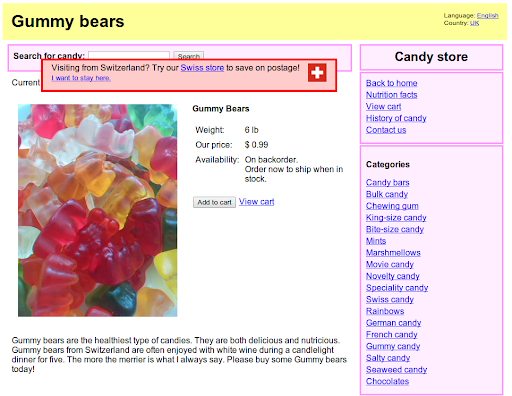Monday, May 12, 2014
If you are doing business in more than one country or targeting different languages, we recommend having separate sites or sections with specific content on each URLs targeted for individual countries or languages. For instance one page for US and english-speaking visitors, and a different page for France and french-speaking users. While we have information on handling multi-regional and multilingual sites, the home page can be a bit special. This post will help you create the right home page on your website to serve the appropriate content to users depending on their language and location.
There are three ways to configure your home page / landing page when your users access it:
- Show everyone the same content.
- Let users choose.
- Serve content depending on users' localization and language.
Let's have a look at each in detail.
Show users worldwide the same content
In this scenario, you decide to serve specific content for one given country and language on your home page / generic URL (https://www.example.com). This content will be available to anyone who accesses that URL directly in their browser or those who search for that URL specifically. As mentioned above, all country and language versions should also be accessible on their own unique URLs.

Let users choose which local version and which language they want
In this configuration, you decide to serve a country selector page on your home page / generic URL and to let users choose which content they want to see depending on country and language. All users who type in that URL can access the same page.
If you implement this scenario on your international site, remember to use the
x-default rel-alternate-hreflang annotation
for the country selector page, which was specifically created for these kinds of pages. The
x-default value helps us recognize pages that are not specific to one language or
region.

Automatically redirect users or dynamically serve the appropriate HTML content depending on users' location and language settings
A third scenario would be to automatically serve the appropriate HTML content to your users
depending on their location and language settings. You will either do that by using server-side
302 redirects or by dynamically serving the right HTML content.
Remember to use x-default rel-alternate-hreflang annotation on the
home page / generic page even if the latter is a redirect page that is not accessible directly for
users.
Whatever configuration you decide to go with, you should make sure all the pages—including country and language selector pages:
- Have rel-alternate-hreflang annotations.
- Are accessible for Googlebot's crawling and indexing: do not block the crawling or indexing of your localized pages.
- Always allow users to switch local version or language: you can do that using a drop down menu for instance.
Reminder: As mentioned in the beginning, remember that you must have separate URLs for each country and language version.
About rel-alternate-hreflang annotations
Remember to annotate all your pages—whatever method you choose. This will greatly help search engines to show the right results to your users.
Country selector pages and redirecting or dynamically serving home pages should all use the
x-default annotation.
Finally, here are a few useful reminders about rel-alternate-hreflang annotations in
general:
- Your annotations must be confirmed from the other pages. If page A links to page B, page B must link back to page A, otherwise, your annotations may not be interpreted correctly.
-
Your annotations should be self-referential. Page A should use
rel-alternate-hreflangannotation linking to itself. -
You can specify the
rel-alternate-hreflangannotations in the HTTP header, in the head section of the HTML, or in a sitemap file. We strongly recommend that you choose only one way to implement the annotations, in order to avoid inconsistent signals and errors. -
The value of the
hreflangattribute must be in ISO 639-1 format for the language, and in ISO 3166-1 Alpha 2 format for the region. Specifying only the region is not supported. If you wish to configure your site only for a country, use the geotargeting feature in Webmaster Tools.
Following these recommendations will help us better understand your localized content and serve more relevant results to your users in our search results. As always, if you have any questions or feedback, please tell us in the internationalization Webmaster Help Forum.
